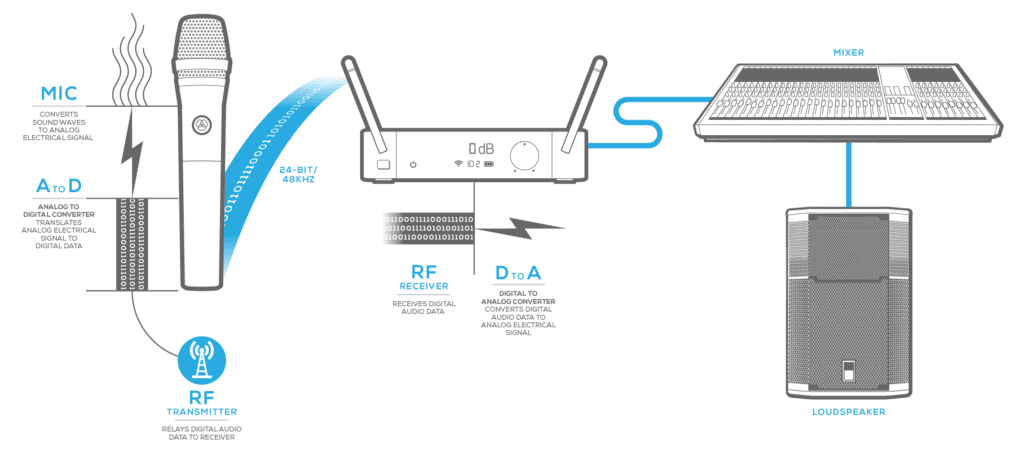Table of Contents
Introduction: Freedom with Wireless Mics:
In the realm of audio technology, the advent of wireless mics has revolutionized the way we communicate, perform, and entertain. Gone are the days of being tethered by cords and cables, restricted in movement and mobility. With wireless mics, performers, presenters, and content creators are empowered to roam freely, unencumbered by the constraints of traditional audio setups. So, let’s embark on a journey to explore the boundless possibilities of wireless mics and unlock the true potential of audio freedom.
The Liberation of Wireless Mics:
Gone are the days of being tethered to a stationary microphone stand or confined to a limited range of movement. With wireless mics, performers can break free from the shackles of cords and cables, unleashing their creativity and energy on stage. Whether you’re a singer belting out high notes, a presenter pacing the stage, or a content creator capturing audio on the go, wireless mics offer unparalleled freedom and flexibility.

How Wireless Mics Work:
At the heart of wireless microphone technology lies a sophisticated system of transmission and reception, enabling seamless communication between the microphone and receiver. Unlike their wired counterparts, which rely on physical cables to transmit audio signals, wireless mics utilize radio frequency (RF) or infrared (IR) signals to transmit audio wirelessly over the airwaves.
Choosing the Right Wireless Mic:
With a plethora of options available on the market, choosing the right wireless mic can seem like a daunting task. From handheld microphones to lavalier mics and headset mics, each type offers its own set of features and advantages suited to different applications. Before making a purchase, consider factors such as frequency range, signal stability, battery life, and compatibility with your existing audio equipment.
Best Practices for Wireless Mic Setup:
A successful wireless mic setup is about more than just choosing the right equipment—it’s also about proper configuration and placement to ensure optimal performance. Start by selecting an appropriate frequency band with minimal interference from other wireless devices. Position the receiver in a central location with line-of-sight to the transmitter, avoiding obstacles and reflective surfaces that could degrade signal quality.

Troubleshooting Common Issues:
While wireless mics offer unparalleled convenience, they’re not without their challenges. Signal interference, dropout, and battery issues can plague even the most seasoned users. To troubleshoot common issues, start by checking for nearby sources of interference, such as other wireless devices or electronic equipment. Ensure that batteries are fully charged and replace them regularly to avoid unexpected failures during performances or presentations.
Tips for Audio Quality Enhancement:
Achieving pristine audio quality with wireless mics requires attention to detail and a few tricks of the trade. Start by selecting the appropriate microphone type for your application, whether it’s a dynamic handheld mic for live vocals or a condenser lapel mic for capturing subtle nuances in speech. Experiment with microphone placement and gain settings to find the optimal balance between volume and clarity, and consider using external accessories like windshields or pop filters to reduce unwanted noise and interference.
The Evolution of Wireless Mic Technology:
As technology continues to evolve, so too do wireless microphone systems. From advancements in digital signal processing to the integration of smart features and cloud connectivity, the future of wireless mics holds exciting possibilities. Look out for innovations such as adaptive frequency hopping, improved battery life, and enhanced audio quality, as manufacturers strive to push the boundaries of what’s possible in wireless audio.
Also Read: Media Streaming Error Detector
Conclusion: Embracing the Wireless Revolution
In a world where mobility and flexibility reign supreme, wireless mics stand as a beacon of liberation for performers, presenters, and content creators alike. With their ability to untether us from the constraints of traditional audio setups, wireless mics empower us to express ourselves freely and authentically, wherever our creativity takes us. So, whether you’re belting out ballads on stage, delivering a keynote address, or recording audio on the move, embrace the power of wireless mics and let your voice be heard—loud and clear.
FAQs: Exploring the World of Wireless Mics
Q1: What wireless microphone is best?
Ans: The best wireless microphone ultimately depends on your specific needs and preferences. Factors to consider include intended use (e.g., live performances, presentations, content creation), frequency range, signal stability, battery life, and budget. Popular options include handheld dynamic wireless mics, lavalier (lapel) mics, and headset mics. Researching and comparing different models based on these criteria can help you find the best wireless microphone for your requirements.
Q2: Are wireless mics worth it?
Ans: Absolutely! Wireless microphones offer unparalleled freedom and flexibility compared to their wired counterparts. They allow performers, presenters, and content creators to move freely without being tethered by cables, enhancing mobility and creativity. While wireless mics may come at a higher initial cost and require occasional maintenance (e.g., battery replacement), their convenience and versatility make them well worth the investment for those seeking a hassle-free audio solution.
Q3: What is a wireless microphone?
Ans: A wireless microphone is a type of microphone that transmits audio signals to a receiver without the need for physical cables. Instead, wireless mics use radio frequency (RF) or infrared (IR) signals to transmit audio wirelessly over the airwaves. This technology enables performers, presenters, and content creators to move freely while capturing high-quality audio, making wireless microphones ideal for a wide range of applications, from live performances to video production.
Q4: What is the difference between wireless and Bluetooth mics?
Ans: While both wireless and Bluetooth microphones offer wireless functionality, there are some key differences between the two. Wireless microphones typically use radio frequency (RF) or infrared (IR) signals to transmit audio to a receiver, providing greater range and stability compared to Bluetooth. Additionally, wireless microphones are often designed for professional audio applications and offer features such as adjustable frequencies and compatibility with existing audio equipment.






